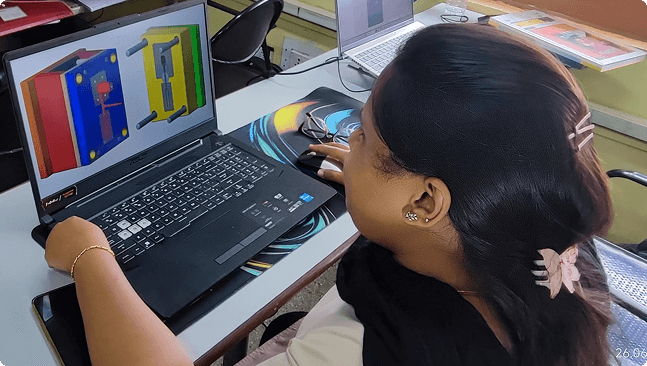
This course is specifically tailored for engineering graduates (B.E./B.tech), equipping them with essential knowledge and skills in subjects such as Press Tools, Mold Design, and related areas. Its primary objective is to enable students to excel in Tool Design, with a specific focus on Press Tools for Sheet Metal and Moulds for Plastics. By undertaking this course, students can acquire proficiency in these domains.
Our brochure offers a comprehensive overview of our courses, programs, and benefits to help you make informed decisions.
Gain a deeper insight into our institution and programs. Our prospectus provides detailed information to guide your educational journey.
To be eligible for this program, a trainee must meet one of the following criteria:
Students can carry on for higher education after the completion of PGDTD programme. Students who possess PGDTD qualification, are eligible for lateral admission to the third semester of PGTE (Postgraduate Degree in Tool Engineering) programme.
The program offers:
Students can carry on for higher education after the completion of PGDTD programme. Students who possess PGDTD qualification, are eligible for lateral admission to the third semester of PGTE (Postgraduate Degree in Tool Engineering) programme.
NTTF School of Postgraduate Studies (SPG)
Post Box No. 5857, 23/24, 2nd Phase, Peenya, Industrial Area, Bengaluru – 560058
The one-year program offered at Bangalore’s Peenya campus provides engineering graduates with advanced theoretical and practical knowledge in Tool Design. The program aims to equip students with the necessary skills to meet the evolving demands of industries, focusing specifically on press tools and molds. Graduates of this program will have ample opportunities for employment in tooling and gauging industries, as well as in CAD/CAM fields.
At NTTF, we connect you with top-notch companies, opening doors to exciting career prospects. Join us and unlock a future filled with success, growth, and limitless potential!






















Boost your confidence with free mock tests designed to simulate real exams. Get instant feedback, track your progress, and improve smarter!


Explore how our trainees shine bright in the industry with NTTF’s guidance and expertise.
Advance your expertise, expand your network, and achieve your professional goals with our industry-aligned postgraduate programs.

The full form of PGDTD is Postgraduate Diploma in Tool Design.
A Postgraduate (PG) diploma course is a specialized program designed to provide advanced knowledge and skills in a specific field after completing an undergraduate degree. It typically focuses on practical and industry-relevant education to enhance career opportunities.
Yes, you can pursue a PG diploma after completing an engineering degree. The Postgraduate Diploma in Tool Design (PGDTD) offered by NTTF School of Postgraduate Studies (SPG), for example, is specifically tailored for engineering graduates in Mechanical, Production, automobile or related fields.
Yes, there are PG diploma programs in engineering, such as the Postgraduate Diploma in Tool Design (PGDTD) offered by NTTF, which focuses on advanced tool design skills for engineering graduates.
A PG Diploma is not equivalent to a Master’s degree. While both offer advanced education beyond an undergraduate degree, a PG Diploma is usually shorter in duration of one year and more focused on practical industry oriented skills, whereas a Master’s degree is more comprehensive and research-oriented.
Yes, a PG Diploma is valuable as it provides specialized skills and practical knowledge that can significantly enhance your career prospects in specific industries. For example, the PGDTD from NTTF prepares students for careers in tool design and related fields.
To be eligible for the PGDTD program, candidates must have an engineering degree (B.E/B.Tech) in Mechanical, Production, Industrial & Production Engineering, Industrial Engineering & Management, Automobile, Aeronautical, or Mechatronics. Additionally, you must pass the SPG – NTTF entrance exam.
The scope of PGDTD is broad, with graduates finding opportunities in designing press tools, plastic molds, die-casting dies, jigs, and fixtures. You can work in tooling and gauging industries, as well as in CAD/CAM fields.
The best PG course after a Bachelor of Engineering (BE) depends on your career goals. If you are interested in tool design and manufacturing, the Postgraduate Diploma in Tool Design (PGDTD) is an excellent choice.
Yes, you can pursue a diploma after completing a BTech degree. For example, a Postgraduate Diploma in Tool Design (PGDTD) can be pursued after a BTech in Mechanical or related engineering fields.
A PG Diploma is a specialized qualification that builds on the knowledge gained in a BTech. While it is not a higher academic degree, it provides advanced practical skills in specific areas, making it valuable for career advancement.
The duration of the PGDTD course at NTTF School of Postgraduate (SPG) is one year, divided into two semesters.
Yes, you can pursue postgraduate studies after completing a BTech. You can opt for a PG Diploma like the Postgraduate Diploma in Tool Design (PGDTD) or a Master’s degree, depending on your career aspirations.
The NTTF School of Postgraduate Studies empowers B.E and B.Tech graduates with specialized programs in Tool Engineering and Product Design, combining expert faculty, hands-on training, and strong industry partnerships for successful careers.